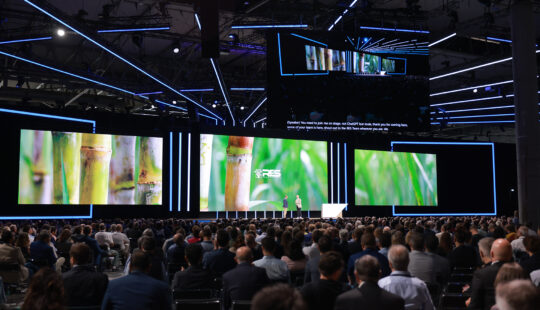It is time to put people at the center of business. That was the heart of the message from SAP SuccessFactors President Jill Popelka last week at SAP Sapphire Orlando.
Speaking at the Build a Sustainable, Intelligent Enterprise that Starts with Your People keynote session, Popelka underscored the urgency for businesses to focus on the employee experience.
“The world has changed since we were last together and work has changed, as well. We realize that it is so important to have people at the center of everything you do,” she said.
That change is having an historic impact on how, where, and why we work, as people rethink how to fit work into their lives instead of the other way around. Human experience at work is now more important than ever for employers that want to create a sustainable workforce and profitable business. As proof of this key shift in the workplace, a recent Wall Street Journal article says that empathy is now one of the leading traits considered for hiring new managers.
“Work has changed in a huge way,” said Maryann Abbajay, chief revenue officer for SAP SuccessFactors. Whether you call it the Great Resignation or the Great Reassessment, she said, “Bottom line, it’s volatility. It’s incumbent on managers to focus on employees by spending time with them and to really focus on the employee experience at work.”
Beyond Empathy: How HXM Solutions Support People Sustainability
In today’s workplace, human resources (HR) has both the opportunity and responsibility to ensure that people are at the center of work by creating an environment in which employees can thrive. This passion for bringing out the individual potential of each employee is the basis for human experience management (HXM), introduced by SAP in 2019. Connecting data, technology, and business strategy enables every organization to create a sustainable workforce where employees have the agency to shape their careers and feel valued for their contributions.
“People sustainability is really about creating a workforce that can evolve in front of market trends,” said Popelka. “The way we achieve that is through something we call the ‘whole self model,’ by focusing on the individual and their desires, needs, and passions.”
The whole self model developed by SAP SuccessFactors is about recognizing the totality of the individual employee, rather than forcing employees into narrow roles or personas. An employee’s passions, talents, and goals are significant to fulfilling their individual potential. Equally as important are their health, well-being, and belonging. The whole self model looks at all these aspects in developing skills and talent for a better employee experience.
SAP SuccessFactors Opportunity Marketplace, launched in November 2021, uses rich, intelligent data to serve up individualized recommendations for career development and internal mobility — whether through new roles, mentors, fellowships, or internal projects. The employee can pursue their passion while the organization can tap into talent that already exists within their workforce.
“We can do so much with our products these days,” said Popelka, referencing the capabilities of the broader suite of SAP S/4HANA for project-based and shop floor work and SAP Fieldglass for contingent workers. “It really provides you the ability to create a total workforce experience through the intelligent enterprise.”
Workforce Planning Gains Speed and Efficacy
Since 1975, the average lifespan of an S&P 500 company has been nearly cut in half. Driving this trend downward is the accelerating pace of innovation, said Amy Wilson, senior vice president of Products and Design for SAP SuccessFactors, as she took the stage during the keynote session to showcase SAP SuccessFactors solutions.
“Agile organizations have the best chance to defy this trend, but they need to do two things,” Wilson said. “The first is to get a handle on their skills gaps and to truly understand how to plan and rectify them. The other thing that they need to do is to quit all of that top-down work on trying to upskill and reskill, but to instead embrace the power and agency of individuals.”
She shared what this looks like within SAP solutions by taking the audience through two scenarios for a fictitious professional services firm with needs for project staffing. One of the challenges facing businesses today is the increased speed of workforce planning. In the past, this business process comprised two distinct segments: strategic, skill-based planning for future needs and operational or headcount planning for more immediate needs. In today’s business environment, these two segments are converging due to the increasing skills gap and pace of change.
The first scenario combined SAP SuccessFactors, SAP Fieldglass, and SAP Analytics Cloud solutions to solve a staffing shortage at the fictitious firm by drilling into the data in different dimensions to identify skills gaps. Based on this analysis, the firm is able to develop strategies to close gaps equitably and with a combination of existing and new headcount. “Thanks to SAP Analytics Cloud, this is possible today in our system,” said Wilson.
The second scenario demonstrated Total Workforce Management powered by SAP S/4HANA Cloud for projects, SAP SuccessFactors software, and SAP Fieldglass solutions to provide a single experience to solve a project staffing manager’s immediate need to find a developer. The manager is able to add a requisition to the SAP SuccessFactors Opportunity Marketplace for an internal candidate and add a requisition to SAP Fieldglass for a contractor. After evaluating responses to the posting, the manager selects a junior employee with the intention to develop early talent.
“This is what the world is all about,” Wilson summarized. “It’s about creating opportunity for eager, young minds and to create those experiential learning situations where we can grow talent.”



